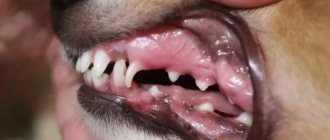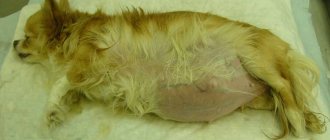Danger of ticks
There are many varieties of ticks, but the most dangerous ones are ixodid ticks. After biting an animal, they can infect it with various diseases. The most common is babesiosis in dogs, in which piroplasmas (single-celled parasites) penetrate the animal’s blood, destroy red blood cells and poison with toxins. The severity of the disease depends on several factors:
- how many parasites bit the dog;
- age of the animal;
- general health;
- correct measures taken.
It is important to know that a dog does not become infected with piroplasmosis when it is bitten by an ectoparasite. To do this, time must pass (2-3 days) during which:
- The female is looking for a place where it is easier for her to bite through the skin. This may take up to 4 hours. Then it is attached to the skin and injects an anesthetic secretion. And only after 1-1.5 days he begins to drink blood.
- After this, under the influence of heat, Babesia transforms into an active form and penetrates from the parasite’s intestines into its blood, then into its saliva.
- When the female has pumped a lot of the dog’s blood into herself, the reverse process begins - she needs to remove excess fluid. And she sprays it into the wound with saliva. At this point, Babesia penetrates the animal’s blood.
In the first day after the bite, the risk of infection is low. Therefore, you have 24 hours to find and remove the tick from your dog.
If the sucked ectoparasite turns out to be a carrier, and is found already filled with blood, then the animal is infected. In this situation, nothing will change depending on how quickly the tick is removed from the dog.
However, not all bloodsuckers are carriers. You can remove 15 ticks from a dog and all of them will be non-infectious, but you can only remove one, and it will be a carrier.
An infected dog is not dangerous to other animals or humans.
How does a tick attach to an animal's body?
Before attempting to extract this parasite, you must first find it. Ticks dig into areas of the skin where blood vessels are located as close as possible to its surface. The favorite places of these insects in dogs are behind the ears, auricles, neck, inside and back of the paws, and groin area.
These are very cunning creatures. As a rule, bloodsuckers wait for their prey, hiding in the grass. They climb to a height of no less than 40 and no more than 80 centimeters. A hungry tick finds its victim thanks to sensory organs that respond to an increase in air temperature, which heats up when a warm-blooded creature approaches, in particular a dog, as well as carbon dioxide exhaled by the target of attack.
Buried tick
Having latched onto an animal, the parasite begins to look for the least hairy place on its body. Having found it, the insect digs into the skin with its trunk and tentacles, on which there are peculiar spikes-hooks. At the same time, it literally grows together with the dog’s skin, becoming like a pea in brown, black, gray, dirty pink color (the shade depends on the type of tick). An embedded parasite is almost impossible to remove from a pet’s body until it drinks blood and falls off on its own.
How to detect it in time: a useful habit
If you have purchased a dog and walk with it every day, create a healthy habit of thoroughly examining your pet after each time you go outside. All types of ticks live in grass and can be found on trees. They have tenacious legs and easily crawl onto the fur when the animal comes into contact with leaves - while walking, running, wallowing, sniffing.
A pet cannot see a tick on its fur - help him with this.
How to properly conduct an inspection:
- When you come home, in good lighting, first look at yourself - first of all, your shoes and trousers (tights);
- put on thin latex gloves;
- carefully feel the fur on the animal in the following sequence: legs from bottom to top, belly, sides, withers, head, ears, muzzle;
- If you find a crawling parasite, carefully pick it up and place it in a jar (it is impossible to crush it with your fingers);
- If the tick has burrowed into the skin, remove it using a special hook, which can be purchased at a veterinary pharmacy.
A burrowing pest not only causes irritation - it can introduce a dangerous disease under the skin and blood . It would be correct to treat the wound with brilliant green and show the animal to a veterinarian to be tested for the presence of pathogens.
How dangerous are ticks for dogs?
Blood-feeding ticks from among the Ixodidae and Argasidae are universal carriers of any infection through a transmissible (through a bite) route. Each type of warm-blooded victim has its own pathogens that lead to illness. In humans, the most dangerous are encephalitis and Lyme borreliosis, and in dogs, piroplasmosis comes first, which, despite the possibility of successful treatment, kills up to 90%.
A tick detected in time is a guarantee that your dog will not suffer much from bites of a harmful insect.
Such deplorable statistics are explained by the delay in seeking veterinary help, but if the treatment turns out to be timely, there is a high probability of a speedy recovery. A slight delay already results in lifelong complications and a longer, expensive period of therapy. It is precisely purebred dogs, as well as hunting breeds, puppies and older dogs that are most susceptible to Babesia infection, even through a single tick bite. Note! Not every bloodsucker that bites into a dog can infect your friend with Babesia, but it’s not worth the risk. It is advisable to have each parasite removed for analysis, especially since dogs usually react calmly to attempts to remove a tick.
When a portion of Babesia enters along with tick saliva, it penetrates into the red blood cells and leads to their disintegration. The dog loses hemoglobin, falls into a coma within a week from the onset of the first signs and dies, continuing to suffer heavily throughout the entire period of the illness.
- The picture of piroplasmosis appears after 2 - 4 days, less often - up to 2 weeks, counting from the moment of the tick bite, and is rapid in nature.
- At first, the dog suspiciously turns away from the previously favorite treat, not to mention the usual everyday food.
- Then her movements become reluctant, sluggish and constrained, as if every step causes her considerable muscle pain, which she is forced to overcome every time.
- At the same time, a high temperature, about 41-42ºС, with chills occurs - the dog is noticeably burning and often, with difficulty, breathes.
- The dog begins to feel sick, vomiting occurs, and sometimes intestinal upset may occur.
- The dog refuses walks, avoids games and tries to hide from his owner’s eyes.
- The dog's mucous membranes turn pale or yellow.
But the primary sign is urine that has changed in color, becoming intensely dark, reminiscent of coffee or tea leaves. Therefore, after you have managed to remove a tick from a dog, you need to observe it for about a week to see how the pet will behave and feel. If there is any suspicious deterioration, take your dog to the vet immediately!
Note! Babesia piroplasmosis is not the only infection that a dog can get when bitten by a tick - there are known cases of infection by rickettsia ehrlichiosis, hemobartonellosis microbes, as well as Lyme borreliosis, which is also common in humans.
How and when to look for a tick on a dog
To remove a tick from a dog, you first need to find it in the thick of its fur. And this requires knowing where and when to look for a bloodsucker. After all, after sucking the required portion of blood, it falls off the victim’s body on its own. But before this, the tick will have time to transmit the entire supply of pathogens concentrated in the saliva, and then the dog will definitely be infected. This is why it is so important to find the tick in order to remove it urgently.
Ticks on dogs should be looked for between walks so that the insect can swell a little with blood and become more noticeable.
- For these purposes, it is important to make a rule to examine your pet from spring to autumn after each walk, carefully feeling its fur.
- The time interval is important here - the tick, having caught on the edge of the fur, crawls onto the skin, closer to the places where it is thinnest and where there is close access to the capillaries.
- Therefore, it is pointless to examine the dog immediately upon returning to the house - it is impossible to find a tick that has not had time to attach itself.
- The parasite must have time to dig in and swell a little so that, once fixed, it can be successfully removed.
- Therefore, the optimal time is not after the completed walk, but before the next one or between them, so that there is a reserve of at least 2 - 3 hours - then there will be a guarantee that the tick can be detected and properly neutralized in time.
No less important are the areas where inspection must be most careful. This is the muzzle, especially the ear area, neck, areas of the inside and back of the paws, stomach, chest and groin.
Note! When palpating, you need to look for an uncharacteristic lump that has formed on the skin under the fur, where it was not there before - it may just be the mite you are looking for.
Tips to help remove ticks from your dog at home:
What you need to know about ticks
Ticks belong to the order of arachnids, and these carnivorous parasites, when they get on the body of an animal, in our case a dog, always instinctively crawl upward. That's why,
Most often, uninvited guests can be found in the dog’s ears, armpits, or thigh folds of skin. It is with an examination of these places that you should begin examining the dog after a walk.
Read more about dog walking rules.
As a rule, insects move slowly and can spend up to several hours on an animal’s body just looking for a suitable bite site. When this place is found, the male bites through the skin, becomes saturated with the animal’s blood and falls to the ground. The female tick, unlike the male, drinks blood slowly, and can attach itself to its victim for a week, or even more. All this time, while it is on the animal’s body, it will poison its body.
What does a tick look like?
Ear mites on a dog
But, in order for you and I to be able to find a tick, after we have learned about its habits, let’s find out what it looks like. When a tick is hungry, it looks like a small spider. But when it is saturated with the animal’s blood, the body of the parasite increases several times, becomes lighter, and if we are talking about a female tick that parasitizes on the dog’s body, then to the touch it looks like a small wart or pea.
If we are talking about an ear mite, then its size is smaller than that of an ordinary tick, but it can also be visually detected on the animal’s body, although it is considered to be subcutaneous. A sign that just such a parasite has settled in your pet’s ear will be a brownish substance on the inner surface of the dog’s ear. It will be enough to take a small amount of this substance with a cotton swab and shake it over a dark surface. After this, look carefully - if you notice moving light dots on a dark surface - these are ear mites.
What harm do ticks cause to a dog's body?
It is the cutaneous forms of ticks that become carriers of such a dangerous disease as piroplasmosis in dogs, and a number of other fatal ailments. Therefore, after discovering a tick on a dog’s body, it must be removed from it as quickly as possible in order to protect the animal from a possible bite that has not yet taken place.
Diseases and symptoms
As already noted, a tick bite can cause serious diseases, the most dangerous of which are:
Piroplasmosis or babesiosis
The most common disease, dangerous for dogs of all breeds and ages. The incubation period is up to two weeks. Symptoms:
- lethargy;
- temperature increase ;
- refusal to eat;
- thirst;
- mild jaundice - the mucous membranes become pale, with a yellowish tint;
- at the peak of the disease, the urine becomes dark, sometimes with a red tint;
- diarrhea, yellowish or greenish stool color;
- vomit .
Borreliosis or Lyme Disease
An infectious disease that can affect all systems of the body, because of this, the symptoms in each individual case are very different. The appearance of any symptoms may begin several months after infection!
Ehrlichiosis
An infection that affects several body systems at the same time. The incubation period ranges from several weeks to several years. This disease knows how to wait. First warning signs:
- poor appetite;
- elevated temperature;
- depressed state;
- reluctance to play;
- sudden weight loss;
- vomit;
- diarrhea;
- bruising on the mucous membranes and skin.
None of these diseases can be waited out or cured at home; at the first suspicion, immediately contact a veterinarian!
The appearance of jaundice after a bite
If you notice that your dog's skin or mucous membranes have turned slightly yellow, this indicates the development of a disease such as jaundice. Usually the causes of this disease are other pathological processes. For example, damaged liver, gall bladder problems. Even an elevated level of hemoglobin can trigger the development of this disease.
But a dog may also develop jaundice after a tick bite, even if the animal did not have any problems with hemoglobin levels, gall bladder or liver before. If a tick has infected an animal with piroplasmosis, then jaundice no longer acts as a disease, but as a separate symptom. Therefore, it is possible that this disease will appear in an animal after infection. Although it is worth noting that this is not the most common symptom. But there were precedents.
In this case, the recovery process takes a long time, and the veterinarian’s task becomes much more difficult. Because there is a need to cure the animal not only of the disease it has contracted, but also of jaundice. After all, this disease also poses a threat to the pet’s life. And without proper therapy, it can serve not only as a reason for worsening the course of the underlying disease. In some cases, jaundice has caused the death of dogs. Therefore, if your animal has become a victim of a tick, be sure to go to the nearest clinic as soon as possible.
If your dog is bitten by a tick, treatment
If you notice the above symptoms, contact your veterinarian to confirm the diagnosis. If a dog is bitten by a tick, then after detection, treatment follows. Main stages:
- Medications are prescribed (imidoxan, azidine, imizol, veriben, berenil, forticarb, imidocarb, pyrostop). They help kill parasites.
- Supportive therapy, taking immunomodulators and cardiac medications that have a beneficial effect on liver function.
- Preventing possible complications or treating them.
It is in the spring, after the snow has melted, that ticks begin to become more active and are ready to look for new victims. It is necessary to remember the danger these parasitic insects pose, because they are literally reservoirs of infection, which they are capable of transmitting even to their offspring. Timely disinfestation will help avoid parasite bites.
Signs of a tick bite and dog behavior
Determining that a dog has recently been bitten by a tick is difficult, but quite possible. Especially if you consider yourself a truly caring owner. To understand whether an animal has really been attacked by a parasite, it is necessary to observe its behavior.
After all, a lethargic dog after a tick bite is not always the case. Moreover, after a long walk, such fatigue is unlikely to alert anyone. And therefore, it is necessary to take a closer look at other indirect signs that may indicate that the dog has been attacked by a parasite.
- Increased sleepiness.
- The animal completely refuses to eat and tries to constantly stay in one place.
- The dog ceases to show interest in everything that surrounds it, although this has not been observed before.
- The animal's body temperature rises.
Sometimes dogs begin to replace food with water. But in especially difficult situations, they may refuse not only food, but also drink. If the tick is on the dog's face or behind the ears, the animal may actively move its head. There may be other signs of concern, such as scratching.
Ticks on dogs are dangerous to humans. You need to wear protective gloves when removing them.
The animal's behavior changes in most cases. But there are also situations where the animal did not demonstrate its anxiety in any way. Consequently, it was simply impossible to understand that the dog was bitten by a tick. And therefore, veterinarians recommend that all dog breeders carefully check their pets immediately after returning from a walk. Especially if the forest is chosen as a place for a walk.
After all, even if the parasite has already fallen off, you will definitely notice the mark from this bite and will be able to react in time. How can you tell if your dog has actually been bitten by a tick? When examining the animal, try to examine the skin as carefully as possible. Part the fur and take a closer look. Pay special attention to areas with thin skin: ears, neck, stomach, armpits. These are the places that ticks will target. After a bite, the skin becomes inflamed, so you will not notice the wound itself, but simply red skin.
How to remove ticks from a dog at home
If it is not possible to get to a medical facility, you will have to perform the extraction procedure yourself. To do this, you must know how to remove a tick from a dog at home. Important nuances:
- To begin with, think about where it will be comfortable to sit, you will need good lighting;
- Calm your pet or have someone help hold and distract you during the process;
- Prepare scissors so as to increase the visibility of the bite site, you need to cut the hair there;
- If you plan to submit a tick to a laboratory, then under no circumstances lubricate it with greasy ointments, oil or petroleum jelly;
- You may need a magnifying glass to take a closer look at the specimen at the base of the proboscis;
- Small tweezers, a special device (if available) or a piece of thread are suitable for the procedure.
When everything is prepared, feel free to begin eliminating the parasite. Grabbing the base of the proboscis, try to loosen the individual, while gently pulling it towards you. Try to adjust the pressure so as not to crush the parasite. After healing, like any wound, the mark must be treated with disinfectants.
Dog Tick Remover
On the modern market, there is some variety among devices for extracting these parasites:
- The most popular at this time is Tik Twister. Outwardly it resembles a miniature device for extracting nails. Made from durable plastic, it's easy to use and works just like a nail extractor. It is necessary to capture the individual by placing the base of the parasite's proboscis in the slot, and then, using slightly pulling and swaying movements from side to side, pull out the culprit of your concern. The cost of such a unit is around 150 rubles;
- Quite compact and easy to carry with you - the Trixie hook. The principle of operation is the same, made of plastic, the cost is about one hundred rubles;
- Tick Key is made in the form of a plate with a teardrop-shaped hole. The material is anodized aluminum, available in various colors. The device can be hung as a keychain; a hole is provided for this. The base of the proboscis is placed in the narrowest part of the hole, and is removed with a slightly rocking movement. Prices for it are around 400 rubles;
- Tiked Off resembles a spoon in appearance, made of durable plastic, with a slot. When used as intended, the parasite's trunk must be placed in the narrow part of the slot. Cost starting from 300 rubles;
- Pro-Tick is made of metal and can be hung instead of a keychain or stored in a wallet. Thanks to the material, the tool is durable, and the magnifying glass in the set will help you see even a small parasite. The average price is about 300 rubles;
- Tick Nipper resembles pliers. Their main advantage is that they are universal and suitable for different sizes of insects. The device has a built-in magnifying glass window, and a cup-shaped grip allows you to hold the tick. Prices starting from 300 rubles;
- Trix Tick Lasso is a plastic device that resembles a handle, with a loop on one side and a button on the other, which, when pressed, lengthens the loop. Having hooked an individual, it is easy to pull it out without any effort. Lasso will cost about 400 rubles.
- Tick Remover is a kind of syringe-tweezer. By pressing the button, the tweezers are released. It is necessary to release the button at the attachment point, thereby closing the grips. Thanks to rotational movements and moderate traction, the insect is removed. Prices starting from 150 rubles.
- Groom Professional Tick Remover is quite rarely found on sale at domestic sales points. The device is flat-shaped and equipped with a loop-shaped thread. You can buy from 200 rubles.
- Anti-mite tongs are made of metal wire. When you press, the grips open, then after the device is positioned in the required manner, you unclench and fix the parasite, and then pull it out. Cost from 500 rubles.
The correct algorithm for removing a tick from a dog
When a tick is actually found on a dog, there are two options - take the pet to the veterinarian or remove it yourself. The first option is preferable, especially since there you can also analyze the bloodsucker and make sure of the presence or absence of pathogens that threaten the dog with a serious illness. But a veterinarian only makes sense if you can get to her quickly. If there is simply no such opportunity, then you will have to deal with the tick yourself. Mastering the skills of independently removing a tick from a dog will be useful for the future, because no dog is likely to be immune from ticks. Therefore, every dog breeder should carefully remember the clear procedure for extracting the parasite.
- It is best to remove the tick with tweezers - special ones are sold in pharmacies and points of sale of veterinary supplies. It has a grip that is bent at a right angle, into which you need to carefully insert the protruding body of the parasite right next to the skin. When the tweezers are turned in any direction, the tick is easily removed with a grip without damage - so it is completely suitable for subsequent analysis.
- You can also use ordinary tweezers, but its tips should be positioned horizontally, parallel to the skin, and not vertically or at an angle. The gripper should be used to pry under the body of the tick, at the point where the head enters the skin. If you fix it by the body itself, you can inadvertently crush the tick. Holding the tick firmly, you should unfold the tweezers with a twisting motion - it will easily separate in one piece. You shouldn't pull it up - it may rupture, and then the head and proboscis will remain under the skin.
- If you don’t have any tools at hand, wrap your fingers in any clean cloth or bandage and begin removing the bloodsucker. Make a clamp with your fingers at the base of the body, as close as possible to the point where the tick enters the dog’s body, and confidently twist the parasite in any direction. Do not try to tug or pull up - it is securely fixed inside with claws, so it is more likely to rupture than to successfully remove it.
- All that remains is to disinfect the dog’s bleeding wound left by the tick. Peroxide, alcohol or any other antiseptic is suitable for this.
Note! To facilitate removal from the dog’s body, it is permissible to moisten the tick with any alcohol solution and nothing more! Other liquids are more likely to harm than help.
How to protect your dog from ticks
Measures to prevent a dog from being infected by ticks include treating the animal’s fur with acaricidal agents and thoroughly examining the dog after each walk. If a parasite that has already penetrated under the skin is found on the pet’s body, it must be carefully removed. It is better if this is done by a veterinarian. Ticks that have not yet become attached can be easily combed out of the dog's fur with a brush.
Tick protection products are available in the form of sprays, drops, and gels. The most popular drugs are “Amitan”, “Bars”, “Defendog”, “Decor”. During the season when parasites are active (late spring – summer – early autumn), the dog’s fur should be treated with acaricides once a week. For additional protection, it is recommended to use flea and tick collars.
What to do after deletion
Destroy small insects, preferably with open fire. Parasites in a tightly closed bottle can remain viable for months. Place a large, blood-fed parasite in a bottle so that, if necessary, you can send it to the laboratory to identify pathogens. Small settlements are deprived of equipment, specialists, and reagents for analysis. The cost of a comprehensive study using the PCR method is 1500-2000 rubles. Within 1-3 days you will receive the result.
Outbred dogs may be immune to piroplasms; the disease occurs in a chronic or asymptomatic form. Pedigree animals have a hard time withstanding the invasion. When the dog’s temperature rises to 41-42 degrees, loss of appetite, dark urine, seek veterinary help.
If a hunting dog is sick and has been cured, it cannot be used this season. The dog is prescribed medications according to the diagnosis. Piroplasmosis (babesiosis) is considered the most dangerous disease in dogs. To make a correct diagnosis, you need not a tick, but a drop of blood from the pet’s ear, more than 14 days after the bite. To monitor the effectiveness of treatment, the analysis is repeated after 2 months.
Possible mistakes
When trying to remove a tick from a dog at home, pet owners often make mistakes:
- Pulling out the parasite
All movements should be to twist the tick out of the dog. Sharp jerks and pulls are unacceptable. Twisting can be done not only clockwise, but in any direction (the main thing is not to change the direction). The parasite has spines on its proboscis. When rotated, they become attached to the proboscis and allow the bloodsucker to be removed along with the head.
- Use oil
Some dog breeders, in order to remove ticks from a dog, recommend dripping vegetable oil on them to block the access of oxygen. Vaseline and machine oil are used for the same purposes. The parasite may suffocate and even fall off, but it will have time to release the pathogens into the blood. Time will be lost because the method is slow.
- Pressing with fingers
Do not put pressure on the parasite's body. If he turns out to be a carrier of the infection, the infected blood will get into the wound on the skin much faster.
Caring for your dog after tick removal
If you manage to rid your dog of ticks yourself, you need to:
- Inspect the wound to see if the arthropod's head remains inside. If so, the area needs to be disinfected and the residue removed with tweezers. If this is not done, there is a risk that an inflammatory process will begin. In this case, it is inconvenient to work with a needle; you can pick the wound too much.
- If the head cannot be removed, the wound is regularly lubricated with iodine. The dog’s body itself will reject the foreign body after some time.
- If the wound is clean, it is treated with any antiseptic: brilliant green, iodine, peroxide, alcohol.
After the parasite is removed, there is no point in immediately taking the dog to the veterinary clinic and removing the tick from the dog for testing. On the first day, protozoa are not detected in the peripheral blood. Therefore, the result of the analysis will be negative, but also false. Accurate results appear within 3-4 days. And even with a negative indicator, a repeat analysis is done on days 5-7.
It is also impossible to determine from the ectoparasite itself whether it is a carrier or not. An infected tick does not look different from a normal tick. Even if he is a carrier, it is not a fact that he was the one who managed to infect the dog.
Females drink the blood of animals. Having sucked, they do this for 5-7 days, inflate and become like a large dark pearl. Then the female falls off her body - she needs to lay eggs in a secluded place to continue the race. Therefore, if a small, newly attached tick is found and the dog develops symptoms of the disease, then the culprit may not be this one, but a completely different specimen that has fallen off long ago. After all, symptoms of infection can appear from 3 to 21 days after the bite. The owner only has to monitor the pet and measure the temperature up to 5 times a day.
The removed tick is destroyed. And it's better to burn it. The fact is that if the female was a carrier of piroplasms, then her offspring will also be infected.
Symptoms of a tick bite
The disease is difficult for puppies and young dogs (most often purebred). Symptoms are less pronounced in older dogs. As soon as a tick bites an animal, the causative agents of encephalitis enter the bloodstream. After 7 days from the moment of the bite, death occurs. If you prescribe adequate treatment and follow it, this can be avoided. The problem is that detecting signs of a tick bite is not easy. Inexperienced owners risk killing their dog due to inattention. Most owners begin to notice changes in the dog’s behavior only when the pet becomes ill.
Diagnosis and detection of a tick is also complicated by the fact that if the tick drinks blood, it will fall off on its own. In this case, you may not even know about the bite. Characteristic symptoms of a tick bite:
- temperature rise to 42 degrees;
- lethargy, passivity;
- refusal to play;
- avoidance of people's company;
- loss of appetite;
- rapid breathing;
- high pulse;
- vomiting (possibly with mucus or blood);
- darkening of urine (stage of irreversible disorders);
- diarrhea;
- red eyelids, mouth and lips, which then turn pale;
- weakness in the hind legs, stiff gait;
Death occurs a week after infection and the onset of symptoms. The severity of symptoms is weakened if the pet has a strong immune system or has previously had piroplasmosis.
Where to look for ticks on a dog
Ticks begin to wake up when the ground warms up to 5 degrees Celsius. This can occur in the early months of spring, March-April. They cannot tolerate heat, so in the spring there is the greatest risk of catching an “unwanted guest.” In summer you need to be careful in the morning or evening when there is a little coolness. Favorite places of such parasites:
- grass thickets;
- places near rivers and bodies of water;
- forests;
- edges;
- bushes.
How dogs are attacked by ticks
To begin treating ticks in dogs, you need to detect them. To do this, after each walk in the above-mentioned places and seasons, you need to examine your dog to identify the parasite. Particular attention should be paid
- neck;
- paws;
- armpits;
- groin;
- chest area.
An inspection is required even if the dog was treated with special anti-tick sprays before the walk. The insect can be detected by feeling a pimple-like bump.











